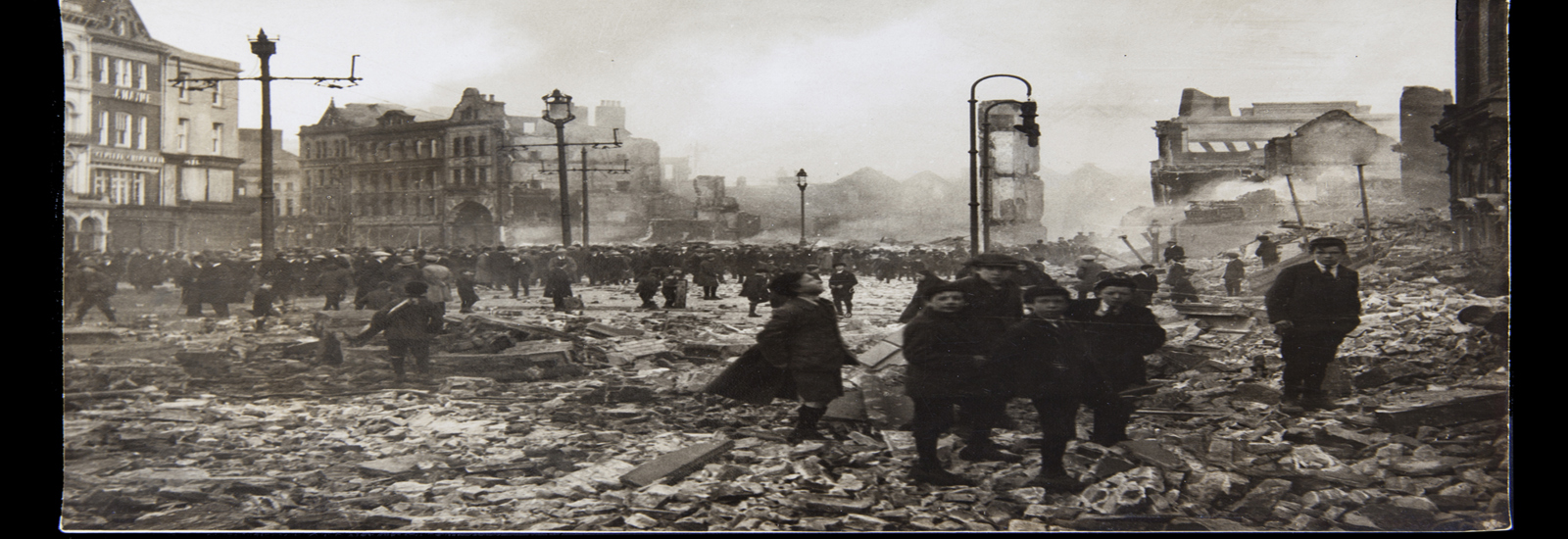Cork Commemorative Jersey Exhibition
This exhibition features the commemorative jerseys of Cork clubs, intercounty sides and international teams with a Cork connection. All those included in the exhibit commemorated Irish revolutionary figures and / or events on their kits during the Decade of Centenaries (2016-2023).
Cork Intercounty

Cork hurlers and footballers provided a notable piece of Cork GAA history as a Rebel team to take to the field wearing black jerseys for the first time.
In terms of the Irish War of Independence, 1920 was a stand-out year where Cork was concerned and the special commemorative shirts worn mark the centenary of a tumultuous 12 months.
The jerseys primarily feature images of two men who died in 1920 while holding the title of Lord Mayor of Cork, Tomás Mac Curtain and Terence McSwiney, and the Kilmichael Ambush and The Burning of Cork also feature. Designed by Cork County Board in conjunction with kit manufacturer O’Neills, the jersey is black with red accents.
Mac Curtain, a councillor representing the original Sinn Féin, was elected Lord Mayor of Cork in January of 1920 but in March of that year he was murdered by members of the Royal Irish Constabulary
He was succeeded in the role by MacSwiney, who was arrested in August 1920 and interred in Brixton Prison. There, he went on hunger strike and died in October. The following month, the Kilmichael Ambush took place, an event considered crucial in the war. Then, in December, an ambush of Auxiliary forces led to a brutal retribution as The Burning of Cork saw damage to numerous houses, businesses, City Hall and the Carnegie Library.
Cork’s sponsors Chill Insurance agreed to have their logo rendered in white rather than the purple and green version which adorned the usual Cork kit.
Black is the latest addition to the Cork palette. When county colours first had to be registered more than a century ago, Cork’s choice was blue and saffron – replicas of these jerseys were worn against Kilkenny in 2016. However, not long before the Munster championship clash with Waterford in May 1919, the county board offices at Cook St were raided by British forces and the jerseys were seized. A frantic search for new kit ensued and the county board luckily came across a set of red jerseys from the Father O’Leary Temperance Association team, which was recently defunct after a merger with St Finbarr’s.
Red and white became the official colours, though the blue and white of Munster became the back-up choice when colour-clashes occurred, such as the 1953 All-Ireland hurling final against Galway and the 1956 and 1957 football deciders against the Tribesmen and Louth respectively.
Denis Hurley
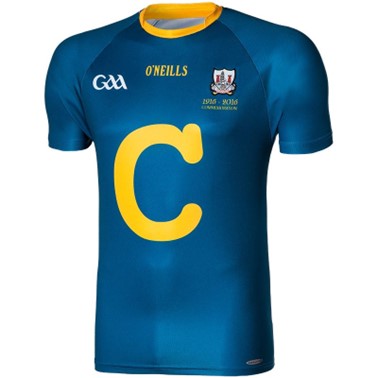
1916 commemoration Cork GAA original jersey in blue with a saffron ‘C’.
Worn by Cork teams until 1919 when the jerseys were confiscated by the British Army in a raid during the War of Independence.
Replaced by the now traditional ‘blood and bandage’ red and white Cork GAA jersey.
May 18th 2019 marked the 100th anniversary of Cork wearing their famed red and white jersey for the first time. The original Cork GAA jersey was a blue and saffron jersey with a large yellow C on it. But in the spring of 1919 the Cork GAA offices in Cook Street were raided by the occupying British forces and the jerseys were stolen and never returned.
With championship approaching and a set of jerseys needed Cork GAA turned to the Fr. O’Leary Total Abstinence Hall team which had recently amalgamated with St Finbarr's and as a result the Fr. O’Leary's jersey were not needed. Those were the famous red and white colours — though with a TA, or total abstinence, logo and were used by the county team. Cork hurlers and footballers played Waterford in a double header on May 18th 1919 in Dungarvan with what was to become their famed red and white jersey first on display. The hurlers defeated Waterford 9-4 to 4-0 while the footballers were defeated 2-0 to 0-2.
In 2016, to mark the centenary on the 1916 rising the Cork hurlers wore a replica of original blue and saffron jersey in a national league game against Kilkenny.
Denis Hurley
Cork Boston GFC

The jersey commemorates the 100-year anniversary of the death of Michael Collins, the most iconic of Irish revolutionaries.
The Cork Boston Gaelic Football Club provides a home from home for many Irish immigrants, but it is backboned by those from Cork and west Cork in particular.
The club decided to honour west Cork's most famous son and remember the sacrifices that he and his comrades gave so that future generations of Irish people could have the freedom to participate in the Irish customs, past-times and sports that are part of our tradition.
Although Collins is the most famous revolutionary of his era, he himself is not recognized in the naming of grounds or clubs that many of his peers are, despite he himself having a GAA background from his time in London. This commemorative jersey recognizes his huge contribution to modern Ireland amongst the GAA community.
Thomas McCurtain’s GAA club, London
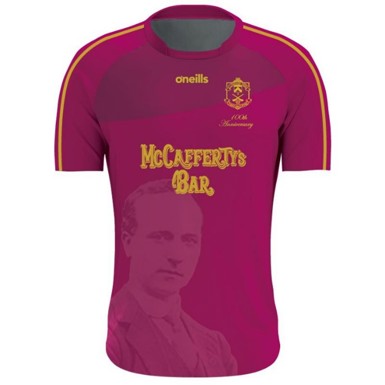
Tomás MacCurtáin’s image featured on the London club’s jerseys in 2020 for the 100th anniversary of the formation of the club and the former Lord Mayor’s death. The club has many historic links with Cork through the “Dagenham Yank” workers at the Ford factory in Dagenham in East London. The Club was founded in 1920 from members of the Forest Gate Branch of the Gaelic League. McCurtain's first fixtures came in 1921 when they entered the first London GAA League & Championships to be played after WW1 in both Hurling and Football with games being played in Manor Park Athletic Grounds. More recently the club has gone from strength to strength with the formation of a Ladies Football Club in 2011 and a Camogie Club in 2016.
Valley Rovers
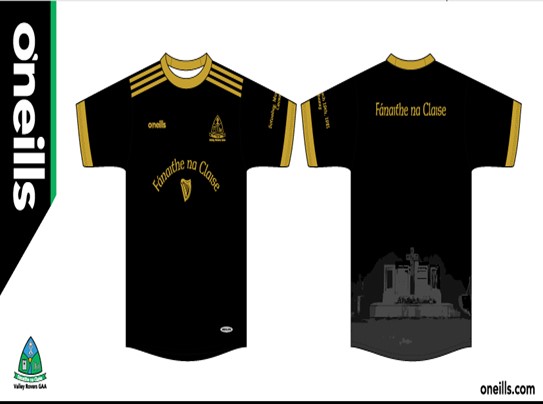
The Upton ambush occurred during the Irish War of Independence on February 15, 1921, near Upton Railway Station in County Cork, Ireland. The Irish Republican Army (IRA) planned an ambush on a British military convoy, hoping to capture weapons and ammunition. However, the ambush was unsuccessful, resulting in the deaths of three IRA volunteers and the capture of several others.
Valley Rovers GAA gained historical significance due to its connection to the Upton ambush. Two of the IRA volunteers involved in the ambush, Michael Fitzgerald and Patrick O'Sullivan, were members of the Valley Rovers GAA club. Both men were captured by British forces following the ambush and later executed.
The Upton ambush is often remembered in local history and the connection to Valley Rovers GAA serves as a reminder of the involvement of ordinary individuals in the broader events of the Irish War of Independence.
Delany's
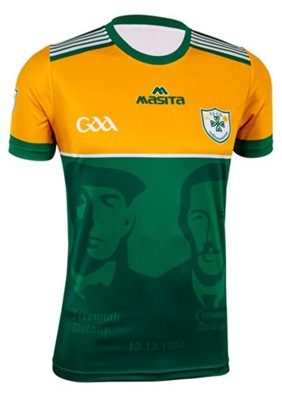
Delany's commissioned these jerseys with the Delany brothers on it, in 2020. As the club is named after these brave brothers, and 2020 marked the centenary of their murder, by British soldiers, the club felt it was an appropriate time to commemorate them accordingly.
The two volunteer brothers, Jeremiah and Cornelius, were shot by Crown Forces on the night of the Burning of Cork in Jeremiah’s home. Jeremiah died instantly and Cornelius died six days later at Cork’s Mercy Hospital.
Na Piarsaigh
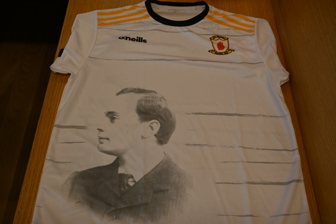
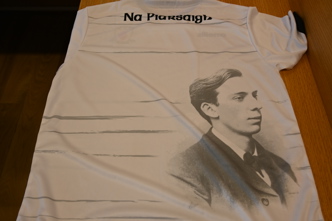
In 1943 a group of idealistic young men drawn mostly from the famed hurling nursery of North Monastery laid the foundations of Cumann Iomána & Peile Na Piarsaigh.
These young schoolboys influenced by their education at North Mon. had a great love for national culture and games. They felt that existing clubs, and indeed the GAA itself, were not aspiring to the founding ideals of the association. They set about change and an informal meeting was held under a lamppost outside No.3 (St.Ita's) Redemption Road. In an effort to become properly organised, the first formal meeting was held in the presbytery of the North Cathedral.
Meanwhile, the youthful members in an effort to achieve higher status and greater influence called upon one of their teachers, Donnacha Ó Murchú, for guidance and assistance. This led to him becoming the first Uachtarán of the club. The following officers were elected at the first meeting: Uachtarán Donnacha Ó Murchú, Runaí Derry Terry, Cisteoir Paddy Sutton. In choosing a name for the club the members sought one which would reflect their aims and ideals. Pádraig & Willie Pearse, it was felt, because of their underlying love of Ireland and all things Irish, reflected those ideals admirably. Thus, the name "Na Piarsaigh" was adopted.
Fermoy
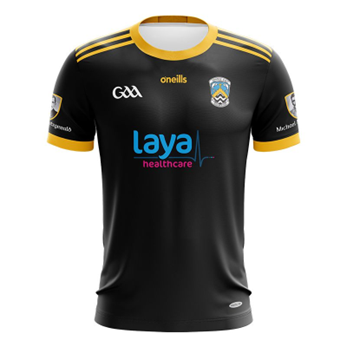
The Fermoy Jersey is a commemoration to the freedom fighter who died on hunger strike in 1920 and the club grounds are named after him.
Michael Fitzgerald, who was born in 1881, died on hunger strike in October 1920, the first IRA volunteer to die in such a way during the War of Independence, but he is overshadowed in public memory by fellow hunger-striker Terence MacSwiney, the Lord Mayor of Cork, who died shortly after.
Having had a variety of employment in the area, Fitzgerald joined the ranks of the local Irish Volunteers after the 1916 Rising, with the arrests of the Kents from Castlelyons – and the execution of Volunteer leader Thomas Kent – a factor.
After involvement in a series of arms raids, Fitzgerald was charged with possession of seditious literature in 1919 and spent three minutes in solitary confinement in Cork Gaol.
Later that year, on September 7, Liam Lynch led members of the Cork No. 2 Brigade in what became known as the Fermoy arms raid, an attempt by the Volunteers to seize arms belonging to members of the South Shropshire regiment as they made their way to a local church. It was the first military engagement the Irish Volunteers had had with British soldiers since the Easter Rising.
At 10.30am that morning, 14 soldiers and a corporal marched from the British military barracks in Fermoy to make their way to the Wesleyan Church. Fitzgerald was among the 25 or so Volunteers involved in the ambush, in which 19-year-old British soldier Private William Jones died. A reprisal by the British military – the first of its kind – followed in Fermoy that night. Fitzgerald and four others were later taken into custody and held in cells in the local RIC barracks. Fitzgerald was later charged with the murder of the soldier who was shot dead in the Fermoy arms raid. He refused to recognise the court.
During the summer of 1920, the trial was transferred to Derry. There on July 21, the grand jury acquitted several of the men. However, Fitzgerald, along with two others, were deemed to have taken part in the killing of Jones and were remanded in custody.
Fitzgerald began a hunger strike at his continued detention without trial in August 1920. It would last just over two months. By October 10, Fitzgerald was unable to take a drink of water, and his sight and hearing began to fade. Over the next few days, he was in a semi-conscious state and on October 15 he lapsed into unconsciousness. It was at 9.45pm on October 16, the 67th day of his hunger strike, Michael Fitzgerald died surrounded by priests and nuns reciting the rosary.
From Cork City, Fitzgerald’s coffin was taken from Cork city for a funeral mass at St Patrick’s Church in Fermoy. Arrangements were made for Liam Lynch, then on the run, to pay his respects on the night prior to the funeral.
In 1922, Fermoy Urban Place voted to rename Old Market Place in Fermoy town to Fitzgerald Place. In 1945, the GAA grounds – on the site of a former British Army barracks, were named Michael Fitzgerald Park. On the 50th anniversary of Fitzgerald’s death in 1970, a memorial to him was unveiled by his family and surviving comrades in O’Rahilly Row in Fermoy, still standing today at the site of the Fermoy arms raid in September 1919.
Speaking at the launch of the commemorative jersey, former Fermoy chairperson and current development committee member Brendan Keane said: “As a keen Gaelic games supporter he would be gratified with the ongoing development of the facilities named after him.
Denis Hurley – The Echo, 04 AUG, 2022
Kilmichael

On the 28th day of November 1920, General Tom Barry led a group of young men of the 3rd West Cork Brigade to the parish of Kilmichael to battle and defeat forces of the British Empire. Kilmichael GAA chose to commemorate this event on the 100th anniversary of the battle in the parish of Kilmichael. The jersey has a picture of the monument which is standing at the ambush site and the rear has a picture of the 3rd West Cork Brigade. "Forget not the Boys of Kilmichael" is also quoted on the jersey.
Diarmuid Ó Mathúna’s

In 1968 the newly formed GAA club in Castletownkenneigh was looking for a name. Being a few years after the 50th anniversary of the 1916 rising, the idea of honouring a local Irish patriot was proposed.
It was decided to commemerate the life of Jeremiah O’Mahony and so it was that Diarmuid O’Mathuna GAA club was named.
Jeremiah was born in 1891, the eldest of 7. He lived in The Paddock townland and went to school in Castletown. He became involved in the running of the family farm- some of the fields he farmed are now part of the Diarmuid O’Mathuna GAA club playing pitches.
He joined the I.R.A. and reached the rank of Captain. He took part in many engagements with the British Armed Forces, most notably at the Kilmichael Ambush. He worked behind the scenes for the I.R.A. in the local area organising recruitment and training. He was involved in drill exercises, fundraising and the maintenance of secret arms dumps.
Jeremiah was accidentally shot at Ballyvelone Cross on the 5th of March 1921 and tragically died of his injuries. A monument to Jeremiah now stands at the cross. He was buried in Casletown alongside the fallen from Kilmichael Ambush. To mark his 100th anniversary a commemorative jersey was commissioned bearing the image of Jeremiah on the front and the image of the monument to Jeremiah (at Ballyvelone Cross) on the back. The club also launched their website – www.diarmuidomathunagaa.com to ensure that Jeremiah’s name would be carried far into the future.
Béal Áthan Ghaorthaidh
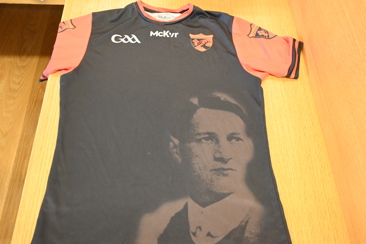
The Béal Áthan Ghaorthaidh jersey commemorates the former Lord Mayor of Cork, Terence MacSwiney, who died on hunger strike on 25th October 1920. The Gaeltacht village of Ballingeary was a hub of Republican activity during the revolutionary years. The home of the Irish college, Coláiste na Mumhan, it attracted the likes of MacSwiney and Tomás Mac Curtain. The club pitch is named ‘Páirc Traolach MacSuibhne’ in honour of MacSwiney.
Brian Dillon’s
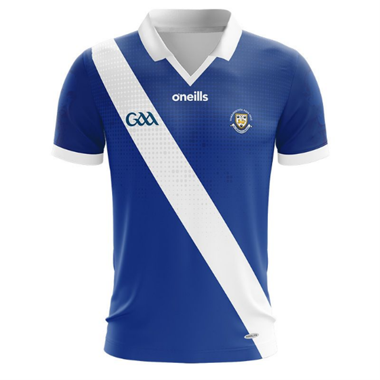
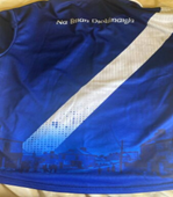
The Brian Dillon’s commemorative jersey marks 150 years since the passing of Brian Dillion, the Fenian leader in Cork in the mid-19th century. Dillon’s Cross, the site of the daring attack on the Auxiliaries carried out by A Company of the 1st Battalion of the 1st Cork Brigade at the height of the War of Independence in December 1920, features on the back of the jersey. Founded in 1910, Brian Dillon’s is one of the oldest GAA clubs in Cork city and was originally located in Dillon’s Cross.
Ballyphehane
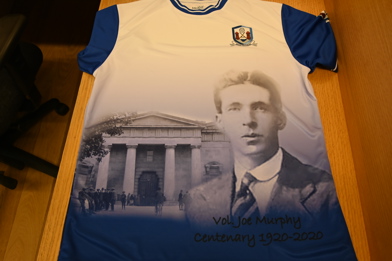
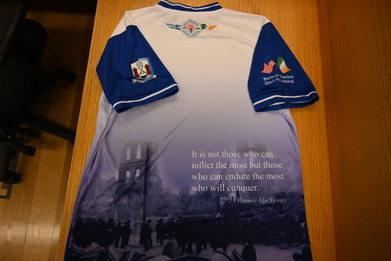
Joe Murphy Centenary Commemorative Jersey
Vol. Joe Murphy’s connection with the GAA and Ballyphehane is extremely strong. Given the significance of his centenary in 2020, we felt the most appropriate way to remember him was to dedicate a local club jersey to honour his selflessness and sacrifice. We decided to tell his story in a visual way and use the jersey as the ‘canvass’ to paint a picture of his life and death on hunger strike.
Joe was a member of the Old Plunkett’s GAA club. We wanted to express our pride as a GAA club and honour Joe’s connection to the GAA family and his love of Gaelic games.
Joe Murphy was born in the City of Lynn, near Boston USA of Irish emigrant parents who subsequently returned to live in Togher in Cork when Joe was two years old – hence the inclusion of the Stars and Stripes along with the Tricolour on the sleeve of the jersey.
He lived in Pouladuff Road in Togher, the street that connects both parishes. Joe Murphy Road in Ballyphehane is named in Joe’s honour. He was a local lad, ‘one of our own’.
Joe died after 76 days on hunger strike on the 25th of October 1920, the same day as Terence MacSwiney. Given MacSwiney’s prominence as Ard Mhéara, Joe had unwittingly but understandably been overshadowed at the time, as the death of MacSwiney reverberated politically throughout the World. We wanted to bring Joe out from under the shadow of the great MacSwiney and give our local lad the recognition he deserved.
We wanted to express our pride as part of the communities that produced and remembers such a heroic and inspirational figure. The inclusion of MacSwiney’s famous quotation on the jersey signifies that MacSwiney was speaking for Joe too.
Joe Murphy died in Cork Gaol, now part of UCC. We wanted the jersey to convey a sense of the historical context and show where Joe died, hence the inclusion of ‘Cork Gaol’ as the backdrop to Joe’s Photograph.
NB: Ballyphehane GAA were among the many community groups that made up the original Ballyphehane 1916–2016 Centenary Commemorative Committee and its later collaboration with the neighbouring parish of Togher as the Ballyphehane-Togher Centenary Commemorative Committee. Both Parishes have a deep connection with Joe Murphy.
St. Vincent’s

St. Vincent’s GAA produced two commemorative jerseys - remembering The Ballycannon Boys and Tadgh Barry.
Ballycannon Boys
The story of the Ballycannon massacre carried out by the British ‘Black and Tan’ forces on the night of Wed’ 23rd of March 1921, is one of pain, of terror and of a sadness that engulfed the whole county of Cork, but particularly the area of Blarney Street from where the young volunteers were born and raised, and from where Cumann Peil agus Imániochta Uinsinn Naofa was founded. It is this strong connection Cumann Uinsinn Naofa has with the story of the ‘Ballycannon Boys’.
The club founded in 1943 was to bring to the youth of the Blarney Street and Sundays Well areas gaelic games and the promotion of Irish culture, which still stands through to this day. A number of years after the club’s foundation when it had consolidated its position as a vibrant club within Cumann Luathcleas Gael, an underage structure was necessary as it was with other clubs throughout the Gaelic Athletic Association. An under 15 league was established in Cork to cater to the youth, this spread nationally throughout the organization. Teams were given names associated with historical Irish patriots, Cumann Uinsinn Naofa was no different in keeping in with the national approach, and it is here where we had our first association as young players with the Ballycannon name, a name which would hold its prominence throughout the decades.
There is no doubt the progression of years did not diminish the memories of the atrocities brought to bear upon those young Blarney Street men and when the club's leadership named Cumann Uinsinn's 1st Fé 15 team ‘Ballycannon’, it was to signify that they were not being forgotten, standing true to this day 100 years on.
The importance of remembering these young men cannot be overstated, it must also be said even prior to that unified club decision some of the club's own people were doing an annual pilgrimage to the village of Kerry Pike laying a wreath with a prayer at the beautiful Celtic cross monument just outside the village.
Today the club now gathers every Easter Sunday morning. Uachtarán Cumann Peil agus Imániochta Uinsinn Naofa lays a wreath while a decade of the rosary is said, the last post is played followed by our national anthem to conclude a morning of remembrance.
Thomas Dennehy – 164 Blarney Street – 21 years
Jerimiah O’Mullane – 227 Blarney Street – 22 years
Daniel Crowley – 171 Blarney Street – 22 years
Michael Sullivan – 281 Blarney Street – 20 years
Daniel Murphy – Orrery Hill off Blarney Street – 24 years
William Deasy - Mount Desert Blarney Road – 20 years
Blarney Street men from the heartland of where Cumann Uinsinn was founded.
This commemorative jersey will hold a special place in the history of the club, in the history of Blarney Street. This link between Cumann Peil agus Imániochta Uinsinn Naofa and the Blarney Street young men, ‘The Ballycannon Boys’ is never to be forgotten.
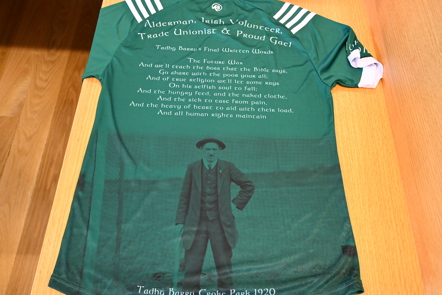
Tadhg Barry
It was a question of remembrance. Here was a man whose life was one of complete giving for a free Ireland, free from over 700 years of British tyranny. Yet the name of Tadhg Barry is little known. He was a full-time organiser for Ireland's largest union, the Irish Transport and General Workers Union, secretary of its Cork branch and an Alderman in Cork City Corporation. He was a prominent journalist for many years as well as a leading Gaelic Athletic Association official and the author of the first rule book for hurling.
A Sinn Féin activist and a founding member of the Irish Volunteers in Cork. A member of the Gaelic League whose love of the Irish language and Irish culture was nurtured having been educated by the Christian brothers in both Blarney Street primary and the North Mon secondary. A proud Cork man, Blarney Street born and raised, his adult life was cut short when he was shot dead in Ballykinlar internment camp in county Down on the 15th of November 1921. Tadhg Barry's death was a tragedy of epic proportion, a huge loss not alone to his family but also to the many areas of involvement he had in our struggle for Irish Independence. Such was his profile; Dublin city came to a standstill. It is recorded up to a quarter of a million people lined the streets to pay their respects. His funeral in Cork was of the same magnitude, showing the same strength in numbers as our martyred Lord Mayors, Tomás MacCurtain and Terence MacSwiney. During this period the Anglo-Irish Treaty was signed, three weeks to the day after his death. What followed was a storm of attention throughout both the media and the general public. With the ensuing treaty split and Civil War, Tadhg Barry was lost in transition.
In the following years a period of development was taking place in the Gaelic Athletic Association. Cumann Uinsinn Naofa was expanding in numbers at underage level, a fé 14 team was introduced to cater for the youth coming through. Following the tradition of naming teams after Irish patriots,the name of Tadhg Barry was not forgotten by the club’s leadership. The significance of this decision shows the historical awareness the club officers had. Today his name is now celebrated and remembered with this commemorative jersey. Cumann Peil agus Imániochta Uinsinn Naofa has not forgotten Tadhg Barry.
O’Neill’s Cork 1916 Commemorative Jersey
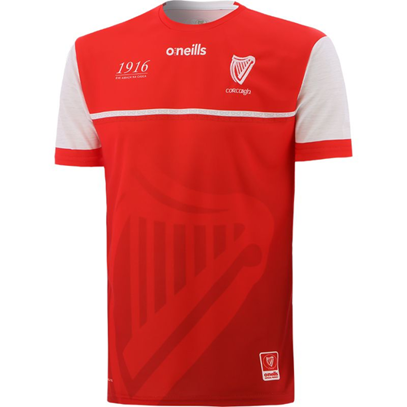

The Cork 1916 jersey features a reproduction of the 1916 Proclamation, water marked harp detail, an embroidered harp and “Éirí Amach na Casca" text across the back of the neck.
Michael Collins Commemoration Jersey – O’Neill’s
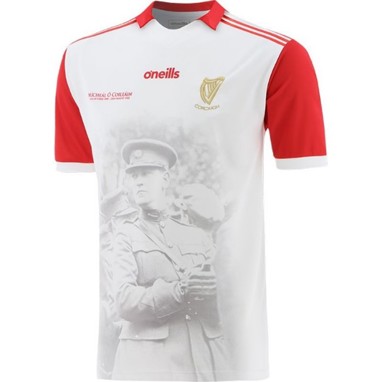
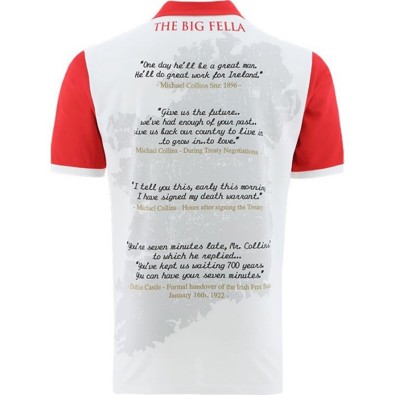
The Michael Collins Commemoration Jersey pays tribute to the Irish revolutionary, soldier, and politician 100 years on from his death. A captivating portrait of Michael Collins is featured on the front with some of the most famous quotes from "The Big Fella" detailed on the back of the jersey.
Ballymartle
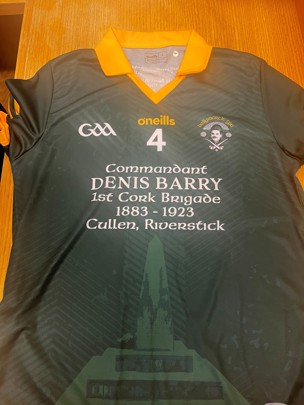
The Ballymartle jersey commemorates the Irish Volunteer, Denis Barry.
Denis (Dinny) Barry - 1883 to 1923
Denis Barry was born in Cullen, Riverstick, on July 13th, 1883. Educated at the local national school, a life interest in the Irish language was fostered by his teacher, Mr O' Leary. An accomplished hurler, Denis originally lined out for his local side, Ballymartle, featuring in the 1906 senior county final. He later transferred to Blackrock, picking up four consecutive senior hurling county medals and featuring in the 1912 All-Ireland with Cork, losing to Kilkenny. An accomplished athlete, winning a Junior A Football County with Nils, Denis was the Cork representative on the National Athletics Executive. He was employed at O'Sullivan and Howard on what is now Washington Street, but Barry continued his interest in Irish and initially joined the Ancient Order of Hibernians before progressing to joining the Irish Volunteers. A new employment position in Kilkenny saw him arrested there following the 1916 Rising and transferred to the Frongach internment camp. Returning to Kilkenny, he involved himself in the campaign to elect WT Cosgrave as a Sinn Féin MP in 1917.
Returning to Cork, he was appointed head of the Republican Police, overseeing public order issues, and working in counterintelligence. He played an essential role in securing property during the burning of Cork and Sean MacSwiney's escape from Spike Island. He adopted an anti-treaty position following the Treaty. Arrested, he was held without charge or trial in Newbridge, County Kildare. Denis joined a hunger strike in October 1923 to protest the prisoners' continued incarceration despite the Civil War ending in May 1923. Denis died on November 20th at the Curragh Military Hospital. Initially, the state refused to return his remains, but the High Court intervened. Returning to Cork, Bishop Timothy Coholan refused permission for his remains to enter a church or a priest to attend his burial. He was buried in St Finbarr's Graveyard, with David Kent TD leading the prayers and Maire MacSwiney delivering the oration. In 2009, the state posthumously awarded Denis Barry his service medals for his contribution to Irish Independence.


